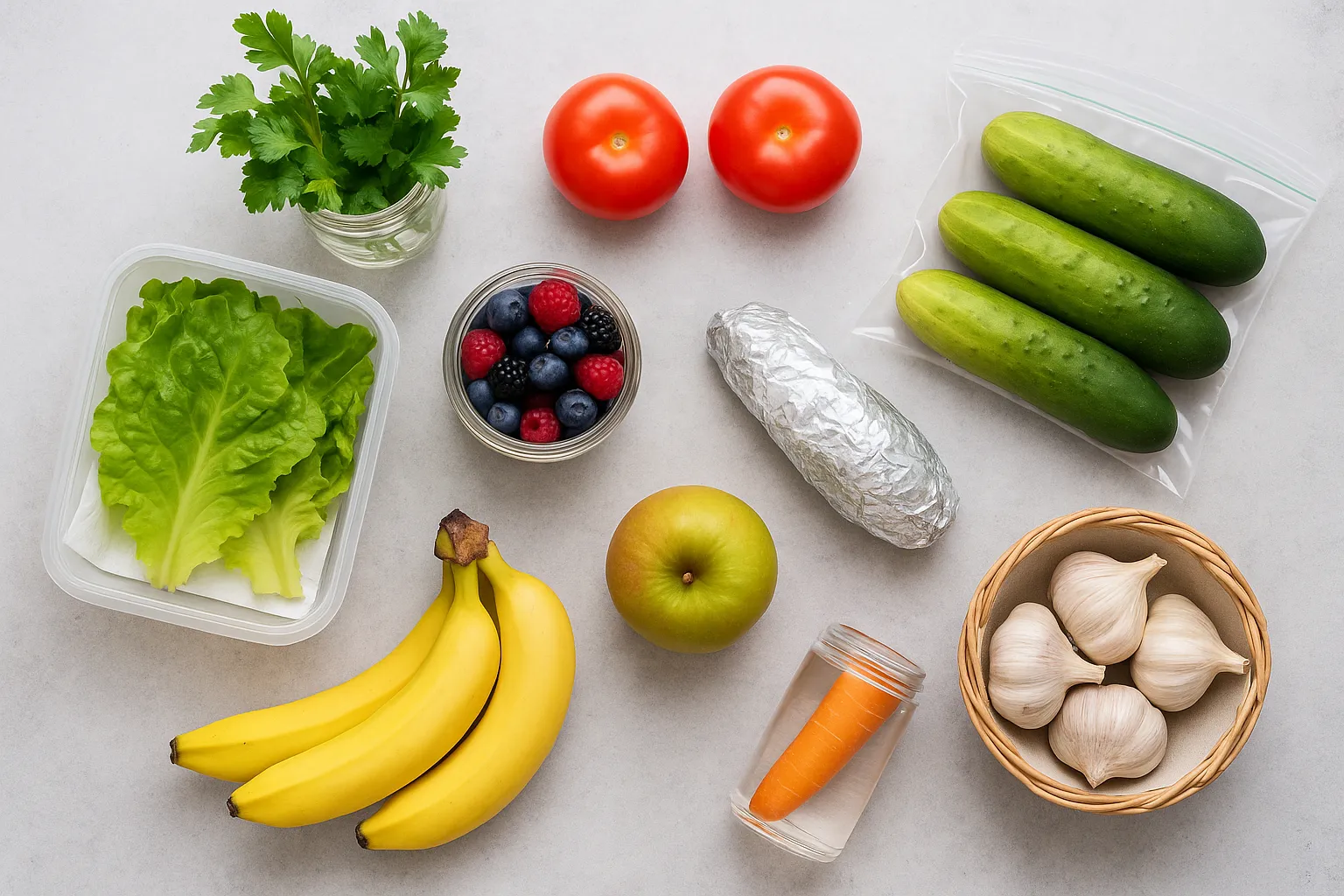Keeping fruits and vegetables fresh for longer isn’t just about saving money—it’s also about making the most of your groceries and reducing food waste. We’ve all been there: buying a big bunch of leafy greens or a carton of berries only to find them wilted or moldy a few days later. The good news is that with a few simple storage tricks and smart habits, you can easily extend the life of your produce and enjoy crisp, flavorful ingredients all week long. Whether you’re meal prepping, cooking for your family, or just trying to keep your fridge organized, these practical tips will help you get more out of every trip to the grocery store.
1. Store Leafy Greens with Paper Towels
Moisture is the number one reason leafy greens go bad quickly. After washing your lettuce, spinach, or fresh herbs, make sure to dry them thoroughly before storing. Once they’re ready, place them in a container or plastic bag lined with a paper towel. The paper towel will absorb excess moisture, keeping the greens crisp instead of slimy. This simple trick is especially helpful if you like buying greens in bulk and don’t want them to wilt after just a couple of days. Pro tip: replace the paper towel every couple of days to extend freshness for up to a week.
2. Use Vinegar Wash for Berries
Berries like strawberries, blueberries, and raspberries are delicious but notoriously quick to mold. A smart way to prolong their freshness is to give them a quick bath in a solution of one part vinegar to three parts water. This rinse helps kill mold spores and slows down spoilage. Just make sure to rinse them again with clean water afterward to remove any vinegar taste, and then dry them carefully before refrigerating. You’ll be surprised how much longer your berries last, and they’ll stay firm instead of mushy.
3. Keep Apples Away from Other Produce
Apples are famous for releasing ethylene gas, which speeds up ripening in nearby fruits and vegetables. That means if you store apples next to bananas, avocados, or leafy greens, you’ll notice those foods going bad much sooner. To avoid this, store apples in their own spot, away from other produce. On the flip side, if you want to ripen something faster—like an avocado—you can actually take advantage of this by placing it in a paper bag with an apple overnight. It’s a clever way to control how your produce ripens depending on your needs.
4. Wrap Celery and Broccoli in Foil
Celery and broccoli often go limp when stored in plastic bags because the trapped moisture speeds up spoilage. A better solution is to wrap them tightly in aluminum foil. The foil allows just enough air circulation to keep them fresh while preventing them from drying out. This method can extend their shelf life by up to three weeks, making it especially useful if you like to buy large quantities of vegetables. For the best results, keep the wrapped celery or broccoli in your fridge’s crisper drawer, where humidity levels are more stable.
5. Freeze What You Can’t Use Right Away
Instead of letting fruits and vegetables go to waste, freeze them before they spoil. Many items freeze surprisingly well, including bananas, berries, spinach, and peppers. Just chop them into pieces, spread them on a baking sheet to freeze individually, and then transfer them into a freezer bag. This keeps them from clumping together and makes it easy to grab what you need later. Frozen produce is perfect for smoothies, soups, or baking, and it’s a great way to save money by reducing food waste. You’ll thank yourself later when you have ready-to-use ingredients at your fingertips.
6. Store Herbs Like Fresh Flowers
Fresh herbs such as parsley, cilantro, and basil can wilt quickly if left in the fridge without care. A great trick is to treat them just like fresh flowers. Trim the ends of the stems and place them upright in a glass of water, then loosely cover the tops with a plastic bag. Basil does best at room temperature, while parsley and cilantro last longer in the refrigerator. This method keeps herbs vibrant and aromatic for days, sometimes even weeks, instead of letting them turn limp in a drawer. It feels almost like having a mini herb bouquet in your kitchen.
7. Keep Tomatoes Out of the Fridge
Tomatoes may seem fine to refrigerate, but the cold temperature actually ruins their texture and dulls their flavor. Instead, keep tomatoes at room temperature on the counter, away from direct sunlight. They’ll ripen naturally, stay juicy, and retain their sweet taste. If you’ve ever wondered why store-bought tomatoes can taste bland, it’s often because they’ve been chilled. A personal favorite trick is to buy them slightly under-ripe and let them finish ripening at home, so they’re perfectly ready when you need them for salads or sauces.
8. Use Mason Jars for Prepped Produce
If you like prepping fruits and vegetables ahead of time, mason jars are a lifesaver. They’re airtight, which keeps pre-cut produce fresher than plastic containers. For example, carrot sticks, celery sticks, and even chopped lettuce can last days longer when stored this way. It’s especially handy if you want grab-and-go snacks or salad ingredients ready to use during the week. Not only do the jars look neat and organized in the fridge, but they also cut down on waste since you can see exactly what you have before it spoils.
9. Store Potatoes with Apples
While apples can spoil other fruits and vegetables, they can actually help keep potatoes fresh. Storing a single apple in a bag of potatoes slows down sprouting because the ethylene gas interferes with the sprouting process. This trick is especially helpful if you buy large sacks of potatoes and don’t want them to grow eyes within a couple of weeks. Just remember to keep potatoes in a cool, dark place and never store them near onions, since onions release moisture and gases that cause potatoes to rot faster.
10. Don’t Wash Until You’re Ready to Use
One of the biggest mistakes when storing produce is washing everything right after you buy it. While it seems convenient, washing adds moisture, which accelerates mold and decay. Instead, keep fruits and vegetables unwashed until you’re ready to eat or cook them. If you do want to prep ahead, make sure to dry them thoroughly with a clean towel or salad spinner before storage. This little habit change can significantly extend the life of your produce and reduce food waste, saving you money and extra grocery trips.
11. Store Onions and Garlic in a Mesh Bag
Onions and garlic need airflow to stay fresh, and that’s why mesh bags or even pantyhose are better than plastic bags. When stored properly in a cool, dark, and dry place, they can last for weeks or even months without sprouting or turning mushy. Hanging them up in a breathable bag also frees up counter and cabinet space, keeping your kitchen organized. A small personal trick is to knot the pantyhose between each onion or garlic bulb, so you can snip off one at a time when needed.
12. Revive Wilted Greens with Cold Water
If your lettuce, kale, or herbs start to look limp, don’t throw them away just yet. Fill a large bowl with cold water and soak the greens for about 15–20 minutes. The cells reabsorb the water, making the leaves crisp again. It’s almost like giving your greens a second life. I’ve often done this with spinach that looked ready for the compost bin, and after a quick soak, it was perfect for a fresh salad. This trick is both a money saver and a waste reducer.
13. Keep Bananas Together but Cover the Stems
Bananas ripen quickly because they release ethylene gas, especially from their stems. To slow the process, keep them bunched together and wrap the stems with plastic wrap or aluminum foil. This slows down gas release and keeps bananas from turning brown too quickly. If you like eating bananas at different ripeness stages, you can separate a few and let them ripen faster while keeping the rest fresh longer. It’s a small effort that makes a noticeable difference in how long your bananas last.
14. Use Cloth Bags for Mushrooms
Mushrooms are delicate and can turn slimy if stored in plastic, which traps moisture. A better option is to place them in a paper or cloth bag that allows them to breathe. Stored this way in the fridge, mushrooms stay firm and flavorful for several days longer. If you’re someone who loves cooking with fresh mushrooms in pastas, stir-fries, or omelets, this simple change can save you from throwing away half-used cartons. It’s one of those overlooked storage hacks that really pays off.
15. Separate Fruits and Vegetables in Storage
Not all produce gets along well in storage. Many fruits, like apples, pears, and bananas, produce ethylene gas that speeds up the ripening of vegetables. Keeping fruits and veggies in separate drawers or containers helps prevent premature spoilage. This is especially important if you want leafy greens and root vegetables to last longer. I learned this the hard way when I used to toss everything together in the fridge and ended up with limp carrots and soggy lettuce. Now, with a little separation, everything stays fresher much longer.
16. Store Cucumbers Away from Ethylene Producers
Cucumbers are very sensitive to ethylene gas, which means if you place them next to apples, bananas, or tomatoes, they’ll yellow and soften quickly. The best way to keep cucumbers crisp is to store them separately, ideally in the crisper drawer where the humidity is higher. Wrapping them loosely in a paper towel before putting them in a plastic bag can also help absorb excess moisture. This small step keeps them crunchy and perfect for salads or snacking.
17. Keep Citrus Fruits in the Fridge
Oranges, lemons, and limes last much longer when stored in the refrigerator instead of at room temperature. In fact, they can stay fresh for several weeks if kept in the crisper drawer. If you prefer to keep a few out on the counter for easy access, that’s fine, but refrigerating the bulk of them prevents them from drying out and losing juice. I’ve found that this is especially useful for limes, which tend to shrivel quickly on the counter but stay plump in the fridge.
18. Store Carrots in Water
Carrots can go limp when left in plastic bags, but they stay firm and crunchy if you store them submerged in water. Place peeled or unpeeled carrots in a container filled with water and cover with a lid before refrigerating. Change the water every few days to keep them fresh. This method works particularly well if you buy carrots in bulk or prep them ahead of time for snacking and cooking. It’s one of the easiest ways to keep them tasting like they just came from the garden.
19. Use a Root Cellar Approach for Squash and Pumpkins
Winter squash, pumpkins, and other hard-skinned vegetables actually store best in cool, dark, and slightly humid conditions, similar to a traditional root cellar. If you don’t have a cellar, a pantry, basement, or even a closet can work, as long as it’s not too warm. These vegetables can last for months when stored properly, making them excellent staples for long-term storage. I like keeping a few varieties on hand through the colder months since they’re versatile and hold up so well without refrigeration.
Fresh produce doesn’t have to spoil before you get the chance to use it. By applying these clever storage hacks, you’ll not only keep your fruits and vegetables at their peak longer but also save money, reduce waste, and enjoy tastier meals. From wrapping celery in foil to treating herbs like flowers, each of these strategies is easy to try and can make a big difference in your kitchen. Start with a few of your favorites, and soon you’ll notice your groceries lasting longer and your fridge looking fresher. It’s all about working smarter, not harder, when it comes to preserving the food you love.


